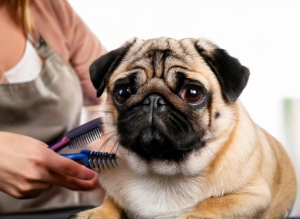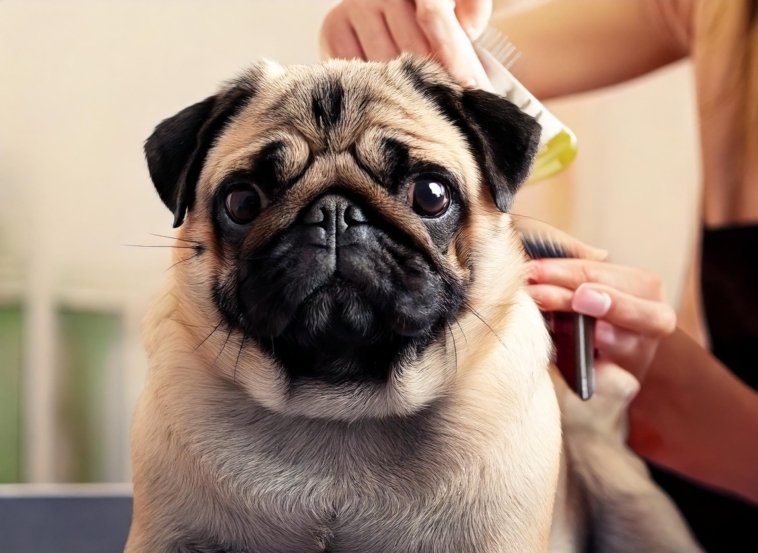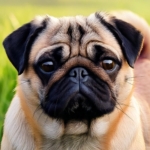Introduction: So, You Think You’re Ready to Groom a Pug?
Having a pug is like sharing your life with a small, obstinate, wrinkly celebrity who insists that you are their personal designer, shrink, and snack person. Their easy coat, enormous eyes, and magnificent face folds translate to grooming not being a hobby—it’s a way of life. If you can’t handle cleaning wrinkles and avoiding fur tumbleweeds, strap in.
Brushing: The Shedding Never Stops
Pugs might be tiny, but they shed enough for you to knit another pug. Once or twice a week, take a soft-bristle brush and give them a good going-over—unless you like adding dog hair seasoning to your meals.
Pro tip: Brush in the direction of the fur at all times, unless you’d like to see a pug’s over-the-top reaction to betrayal.

Bathing: Spa Day or WWE Smackdown?
Bath time every 3-6 weeks is best, except for when your pug finds rolling in strange material so enjoyable. Use a mild dog soap except if you wish to remove their skin oil and leave a miserable, scratching potato.
Shun the ears, unless you have a visit to the vet and a pug grudge that will take weeks to die.
Eye Care: Big Eyes, Bigger Problems
Those cute googly eyes might be fun, but they’re a dust magnet, a goo catcher, and a drama starter. Clean around their eyes every day with a damp cloth and cut any hair that’s sticking into their line of sight—or risk the “I’m judging you” scowl being permanent.
Wrinkle Cleaning: A Fold-by-Fold Operation
Every wrinkle is a trap for moisture just waiting to throw a bacteria party. Clean them lightly with gentle wipes or cloths daily, and dry them thoroughly. Who wants a pug that’s moldy.
Nail Trimming: The Soundtrack of Tiny Taps
If your pug’s nails are clacking like tap shoes on wood, it’s time to give them a trim. You can use clippers or a grinder, but be careful of the quick—cutting it makes your grooming session look like a horror movie.
Bonus points if you make it through the ordeal with all your fingers and your pug’s dignity still intact.
Ear Cleaning: Because “What’s That Smell?” Shouldn’t Be the Theme
Pugs can get ear infections, so clean their ears on a weekly basis. Lift the ear flap, put in the vet-approved solution, gently rub and wipe out the gunk. If your pug glares at you like you’ve messed up their whole week—you’re doing it right.
Dental Drama: Don’t Ignore the Funky Breath
Daily brushing of your pug’s teeth may seem overkill, but they either do this or use halitosis as a weapon. Use dog toothpaste and a dog toothbrush. Add in dental chews and an annual cleaning by the vet if you wish that pug smile to remain adorable (and less poisonous).
Coat Types: Not All Fuzz Is Created Equal
- Smooth Coat: A breeze to handle but still sheds as much as a snowstorm.
- Double Coat: Needs more brushing unless you’re willing to vacuum in increments.
- Coat Colors: Fawn, black, silver—each one elegant, each one shed-tastic
Shedding: The Never-Ending Confetti Parade
Regular brushing, the right shampoo, and a balanced diet with omega-3s can reduce shedding—but let’s be honest, nothing stops it. Embrace the fur. Decorate with it. You’re in it for life now.
Skin Issues: Wrinkles With a Side of Itch
Pug skin is sensitive like a poet in a windstorm. Use hypoallergenic shampoos, wipe their folds daily, and moisturize with vet-approved products. If their diet’s good and their skin’s not flaky, you’re doing great. If not, cue the dramatic pug side-eye.
Establishing a Grooming Schedule: Calendar It or Chaos Reigns
- Brushing: 2–3 times a week, unless you enjoy a fur couch.
- Bathing: Every 3–4 weeks, depending on how much they’ve been “adventuring.”
- Nail Trimming: Every 3–4 weeks or when your floor is a pug drum.
- Ear Cleaning: Weekly. They’ll despise it.
- Tooth Brushing: Daily. They’ll dislike this more.
Final Tips: Survive Grooming, Stay Sane
- Use the proper equipment: This is not a time to wing it with kitchen shears.
- Ensure water temp: Lukewarm, not molten lava.
- Dry thoroughly: Wet pugs are odor queens.
- Avoid the hasty: If you like blood and betrayal, though.
- Take breaks: Pugs are divas. Give them a chance to breathe (and you).
- Watch for signs: Limping, scratching, or squinting? Time to consult the professionals.
Conclusion: Pug grooming may not be glamorous, but it’s an experience rich in wet towels, dog hair, and passive-aggressive snorts. Do it correctly, and your pug will repay you with kisses, hugs, and the occasional sneeze into your mouth.




